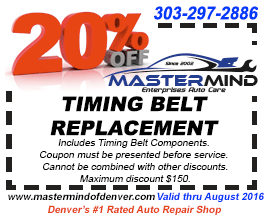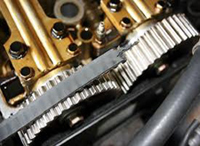A few years ago one of our clients bought an exceptionally nice 1972 long wheelbase Shadow. Like most "clean" Rolls-Royce motorcars of its vintage the car was very clean everywhere but under the hood. That was a mess. It's too old and too complex to be anything else.
He tried all sorts of tricks to spruce it up. Painting, cleaning, and power washing. The bottom line - the Silver Shadow engine bay is not "perfectible" with ordinary cleaning techniques. When compared to the engine bay of a 1972 Chevy, it's ten times as complex. It's no wonder owners left them alone, and showed their cars with hoods closed.
"It's unseemly to have a Rolls-Royce with its hood open."
"And it's not a hood. It's a bonnet."
Many drivers of lesser cars put their tails between their legs and turned away. But the owner of this car didn't do that. He said, "Let's fix it. And let's start from the inside." So that's what we did. We removed the car from the engine, and stripped it to its component parts
This is the same engine as in the top photo, but 1,440 pipes, fittings, assemblies and pieces have been removed to get to the point you see here - a short block, heads, and exhaust manifolds. Looking close you can see how the cosmetic problem under the hood got its start.
We found problems inside too . . . piston rings broken and stuck by sludge. Gaskets that came apart and allowed oil and gas to mix. Bearings that wore out, long before their time. As much as I love Rolls-Royce and the British cars, I see how Daimler Benz did it better, with their 600 Grand Mercedes engine.
Rolls-Royce markets itself as the finest motorcar maker in the world, but the exhaust manifolds are bare rough, rusty cast iron. The heads are painted, but the block is just rough cast aluminum. It was a mess fully assembled, and it's a mess broken down into component parts.
We decided to do it differently, going back together. Here's the block, ready to begin assembly.
As you can see, it's not dirty anymore. We've cleaned it, and finished the outside in silver. The inside is fully blueprinted. Liners pulled and redone, new pistons, line bored crank journals, and everything balanced better than new. The cylinder heads looked like pieces of art.
We did our best to keep the appearance of the engine original, but we addressed some designed-in limitations as we could. For example, these engines did not have front oil seals, so they leaked a small amount from the crank all the time. The used similar low-tech seal for the back of the crank, and that leaked too. We fitted modern rubber seals on both ends which required some crank and block machining but it's invisible in the assembled engine.
We used modern synthetic gaskets in place of leather, paper, and cork. We hope they will be more durable, and the evidence of the newer Crewe-built 6.75 motors says they will be.
Every piece needed attention. The carburetors, front and center atop the engine, looked like this:
The only way to make this right, in my opinion, was to do what we did: take the assembly apart, dismantle both carbs, polish all the pieces and paint what needs painting with durable powder coat. Then we assembled them with new jets, bushings, floats and valves. So they should work like new and look better than new.
Once the block was rebuilt the engine around it began to take shape:
In many cases we had to decide how to finish parts that Rolls-Royce had left as bare metal. The exhaust manifolds were done in a silver high-temp ceramic. The valve covers were refinished in black, but we did the Rolls-Royce logo in silver rather than the original bare aluminum. The step pipes that were not painted were plated. Meanwhile, all the little subassemblies had to be rebuilt - hydraulic pumps, accumulators, valves, water pump and ignition to name a few.
The engine seemed to grow bigger as successive layers were added. And every piece had to be refurbished in some way. Some needed mechanical repair, others jest needed cosmetic work. Every piece needed that, and it was time consuming. Take a look at the box of outer parts:
That stuff looked ok on an old ratty engine but it won't play where we are taking this project. Here are a few of the mechanically good parts after cosmetic cleanup. Quite a difference, wouldn't you say?
And it all came together. In the end there were so many pipes and fittings you could hardly see the actual engine:
One big milestone was joining the engine to the subframe, which was also rebuilt to a better-than-new level of finish and a fully as-new level of performance. Brake calipers were rebuilt, hoses, bearings and seals were renewed, and bushings replaced. The transmission was overhauled and refitted, using a new gear reduction starter.
 |
| Subframe and Strut assemblies (C) JE Robison Service |
 |
| A Rolls-Royce / Bentley subframe - used virtually unchanged from 1965 to 1999 |
 |
| New ball joints, bushes, and hoses, and everything else rebuilt and refinished (c) JE Robison Service |
Once the engine was on the subframe the throttle linkages and piping could be connected. This is no small job on a RR V8. Take a look at some of the detailing in the linkage and piping, and recognize that every single piece must be refinished, sometimes sized or bushed, and fitted and adjusted.
Many of these parts had been left unfinished by the assemblers in Crewe but we did not repeat that. We finished them in clear or silver in most cases. It's certainly an esthetic decision, but to clean them up to be just as made, only to let them rust and go bad, seemed foolish. The sorry appearance of parts like these was the whole reason for the job! And it would not have happened if RR had invested a bit more care at the original assembly. The exhaust pipes are a good example - we did them in clear ceramic, while the factory left them bare, and they were rusty and shabby looking before the cars were even delivered!
We used a tank filled with pressurized oil to verify the integrity of the lubrication system, and prime the pump. The engine was filled through the port for the oil sender. Needless to say, you don't proceed to the next step unless the pressurized oil remains in the engine and not on the floor or the wall.
With all that work to the mechanicals, we had to restore the engine bay in the car, which meant the unibody parts (black, textured, and car-colored, and all the subassemblies (AC evaporator housing, radiator top, all the pipes and hoses, hydraulic reservoir, all the electrics . . . .
In the photos below you see the engine bay being prepped. The frame rails were (and are now) finished in a black texture semi-gloss. The sides of the fender wells are smooth semi-gloss. The shock tops and many other undressed bits are medium gloss black.
This next photo gives a sense of the final engine bay detailing
In that shot you can see that the pipes had to be cad plated. The brake reservoir was redone in silver. The expansion valve is new. The heater fan is cleaned. The wiring is cleaned and re-taped with the original "friction tape" cotton tape. The vinyl duct is cleaned. Most all the black metal was repainted. This is no different from what we'd to restoring the engine bay of a 1930s car but a Shadow era or newer car is vastly more complex and it takes a lot more time as a result. This is the future for all you concours-bound Shadow, Corniche, and Spur/Spirit/Turbo owners as the cars age.
There is a ton of detail in this one image and that is not 10% of the engine. bay.
Here's the whole assembly on the floor, ready for the test fitment:
 |
| 6.75L Rolls-Royce drivetrain (C) JE Robison Service |
If you look close you will see the transmission casing looks dingy and unfinished. The GM400 transmission was rebuilt, and the case is spotless. We have sprayed it with a clear satin protective coat but left its appearance otherwise unchanged as it still has ink stamps (RR) from GM and hand marking with assembly numbers.
 |
| Original marks on a GM 400 transmission supplied to Rolls-Royce |
If you have an original car this is what you will find. If your car has a rebuilt tranny it will likely have been spray painted by the rebuilder and that bit of history will be lost.
All that's needed is the car body, and here it comes:
The result goes well beyond what the folks in Crewe provided back in 1972. There's no way to get this level of detailing other than to do what we did. I can't tell you how proud I am of Bob Toti and the rest of the crew at Robison Service who pulled this off. And I mustn't forget Justin Morini in the powder coat booth, and Al Keinath with the Glasurit paints . . . liquid gold, that stuff, and laid down by a master. I wonder who will be next to do this . . .
As of this writing we are doing the final assembly and hookup. Stand by for the rest or the story, and the rest of the car . . .
(c) 2015 John Elder Robison
John Elder Robison is the general manager of J E Robison Service Company, celebrating 30 years of independent Rolls-Royce and Bentley restoration and repair specialists in Springfield, Massachusetts. John is a longtime technical consultant to the RROC and other car clubs, and he’s owned and restored many fine vehicles. Find him online at www.robisonservice.com or in the real world at 413-785-1665
Reading this article will make you smarter, especially when it comes to car stuff. So it's good for you. But don't take that too far - printing and eating it will probably make you sick.













































